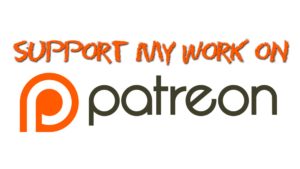My Favorite Technology
With the invention of the radio came claims that, “This will revolutionize education, forever.”
Then came television, and more claims that, “This will revolutionize education, forever.”
Then came the VHS player. You guessed it, more, “This will revolutionize education, forever.”
Then the internet came along, and louder than ever were the claims that, “This will revolutionize education, forever.”
In truth, all of those pieces of technology have revolutionized education. Education is now, more than ever, about coming up with new ways to make information increasingly accessible and more engaging. And, more kids than ever are starting college. What’s not to love, right?
Well, there is plenty not to love.
The reason all of those pieces of technology were destined to change education forever was because they were going to allow experts in particular fields to communicate with students. The thinking was that books and stuffy teachers were making learning unnecessarily difficult. By allowing students to bypass the texts and teachers to gain access to the content to be learned, they’d learn better and faster.
It makes sense to me. As an adult, if I want to learn about writing a blog, for example, I do a search on the internet and find some self-proclaimed blog expert. I watch their videos, read their blogs for advice, and give it a shot! Or, if I want to learn to change the air filter on a new car, and I can’t seem to figure it out myself, I look for videos on YouTube. Technology like the internet has provided me with so much greater access to information that has enriched my life than was afforded before the internet.
That’s how it is supposed to work with students, too. A kid might be stuck in Algebra 2; logarithms killing my grade, mister! They look up “logarithms,” on the internet and there are tons of helpful videos. The student learns how to do logarithms, and their grade is saved.
It sure seems like it is all on the up and up, right? Well…
With up to 60% of college freshmen needing remedial math classes, I’d say these revolutions have not had a positive outcome for students.
At this point you might be thinking, here’s another doomsday message: Kids these days are horrible, fear for the future. I promise you, this is not a doomsday message. Education needs to improve, and that’s what this blog is about.
Let’s take a step back and look at the example where I learned to change an air filter from a YouTube video. Was I educated? Was I trained? What’s the difference?
There is a huge difference between training and education. Training equips the trained with specific skills and knowledge that the trainer knows the learner will need, when they will need it, and how they will apply what they’ve been trained to do. Training is what happens when you get a new job.
Training could be said to equip a person with a specialized tool.
Education is different. People often complain why they weren’t taught certain practical skills in school. The message is that education is worthless.
Education equips a person with the ability to find the specialized tool they need and then figure out how to use it. While training prepares someone for a known task, education prepares someone for an unknown task.
When a student watched a video on the internet about logarithms are they being trained or educated?
If the intent of the video is to help a student complete homework and pass a quiz, then the person knows exactly what the student will need to be able to do, and when they’ll need to do it.
This is a seemingly subtle difference. The difference between training and education is anything but subtle. It is of massive consequence. Why?
One attribute of an educated person is that they quickly incorporate new, more effective approaches. By contrast, a trained person resists new methods, regardless of efficacy. Education makes a person adaptable.
The reason that the radio, television, videos, and the internet have failed to improve educational outcomes is because they have not addressed the short-comings of a textbook. All of these sources provide the same information, and use the same approach. They disseminate information.
A good teacher entices curiosity, finds what motivates students to learn, and provides educational experiences for students. That quality human connection is what makes education happen for students that are otherwise uninterested in being educated (which is an overwhelming majority).
There is such a massive push, with some much inertia behind it, to focus on comprehensible input, scaffolding, all of the components of teaching examined in isolation and treated with a leaning towards training a teacher instead of educating them about teaching, that it feels like quality teaching is becoming a lost art. Maybe that’s a skewed perspective having only taught in Arizona, which by nearly every metric, is the worst state for education in the US.
What students need is a reconnection with their instructor. The instructor needs to get in-tune with the needs, pace, and interests of the students. PowerPoints, videos, SmartBoards, Chrome Books, and the like focus on the dissemination of information.
That is why my favorite piece of technology is the document camera.
Wait … hear me out. I believe that it can be the most powerful piece of technology for a student in a math class.
The first reason why I love the document camera deals with how mathematics is a written, not spoken language. The spatial arrangement of characters conveys meaning. The way math is printed on paper, or a PowerPoint, and the way it is written on the board, is different than how math is written and performed on paper. The physical parameters change the way we write.
In the image below you can see a lot of repeated information. Some of the information is written mathematically, some of it is written in English, and there are arrows and annotation that connects the two. These annotations are done in real time in response to questions from students and answers by students to my questions.
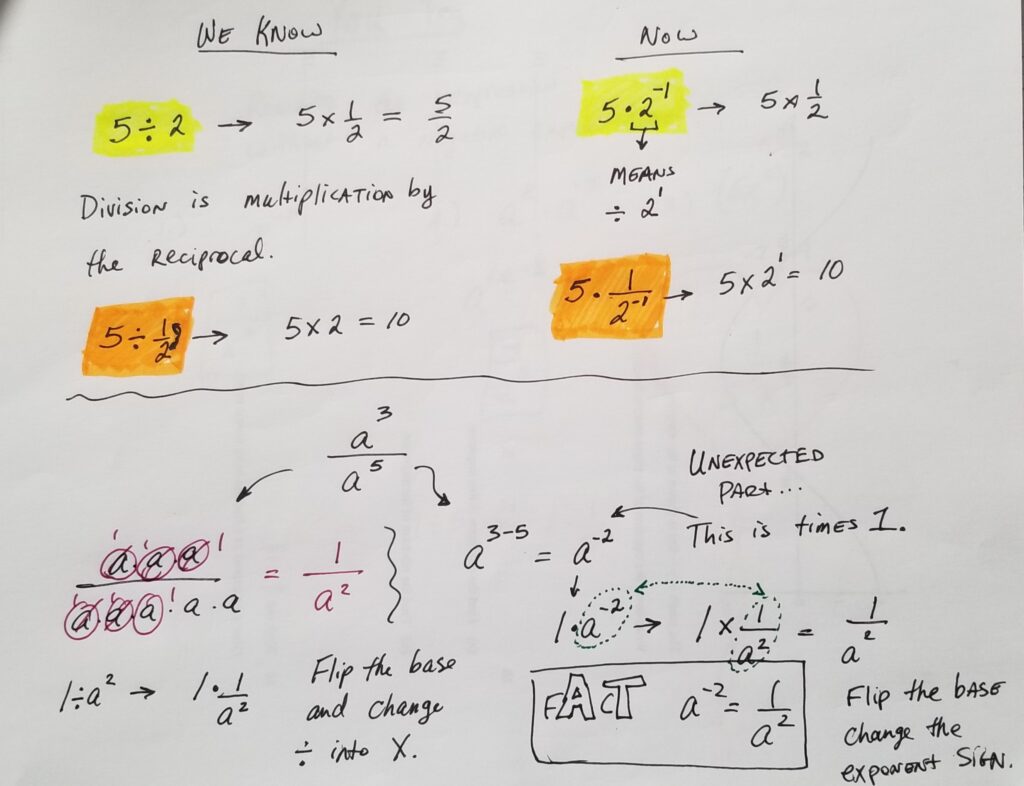
The way we write math greatly impacts how we perform the math. This is an overt example, but I think it will make the point. The first expression below is extremely difficult to deal with, while the second has the same meaning and is quite easily understood.
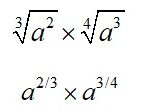
A bright student might realize to rewrite the first expression as the second. But an average student will realize with the second that they only need to add the exponents, and they’re done. This is not an example of how the interaction of math is different when writing on paper, versus typing. What it does show is that how math is written greatly impacts the interpretation of the meaning. That interpretation and translation occurs more naturally when written in real time compared to being typed.
What the example above does show is how writing mathematics drastically changes our interpretation of what is written. In effect, it rephrases the information.
What the document camera does is allow the teacher to show students, in real time, the mechanics of the mathematics, while allowing for discussion and annotation of the theory of the mathematics. It does these things at a writing pace.
Here is a picture of a lesson in Algebra 1.
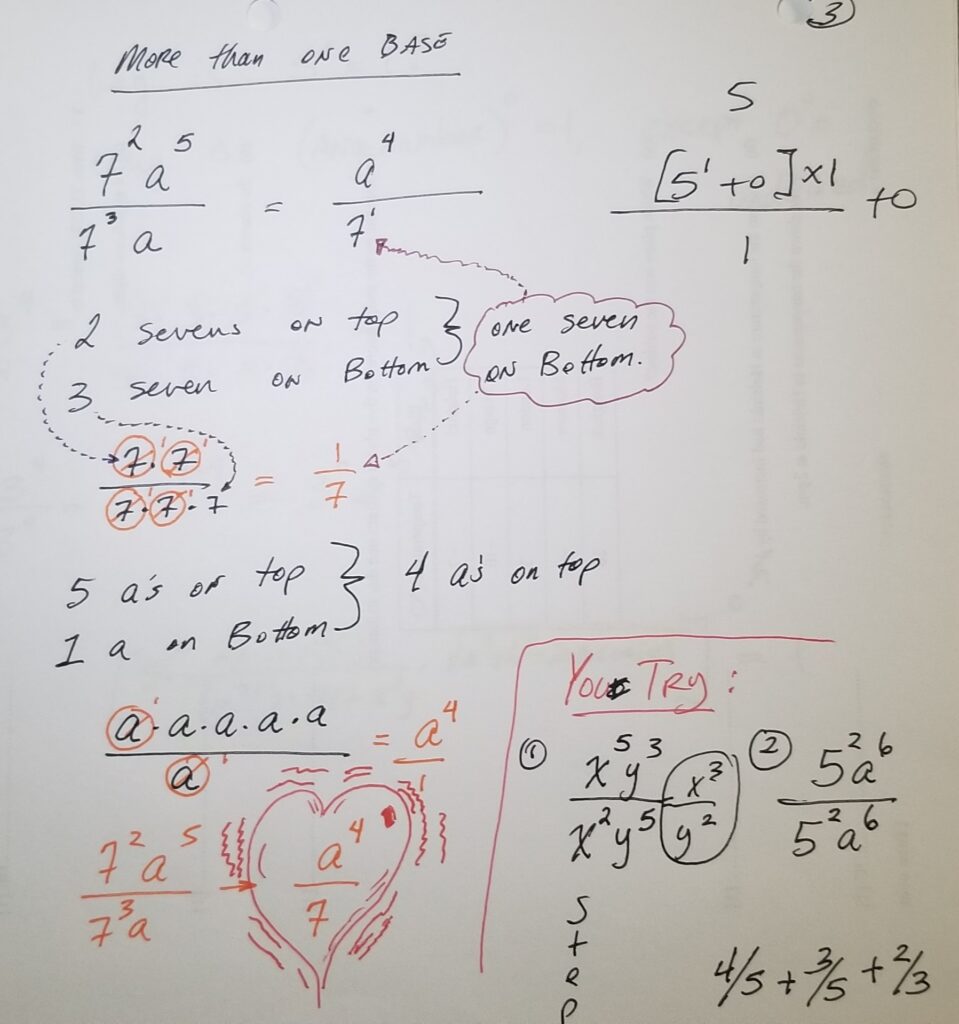
In this picture what you see is how a problem can be broken apart in response to what it is that the students in the classroom, at that very moment in time, are struggling with.
While this could have been addressed while writing on the board, or even in a PowerPoint lesson, it was more apparent to me, as the teacher, because I was going slower. I was asking more questions, students were asking more questions. Teaching with the document camera really can improve the dialogue between teachers and students, changing it from speaking to conversing.
While a conversation can be had over a YouTube video with students, or during a PowerPoint presentation, it is more difficult. The pace is different; the engagement of the students is different. When watching a video, or watching a PowerPoint, students are … watching. If they begin writing, it is often dictation that’s being performed.
There is certainly a measure of dictation happening by students when engaged in a lesson delivered through a document camera. However, the switch to addressing a question or point of confusion during a lesson in a way that students incorporate that response as a natural part of the lesson, happens naturally when using a document camera.
Consider a lesson about exponents. No matter your teaching experience, you cannot anticipate all possible misconceptions, prior or actively developing, and dispel them pre-emptively. Along the way there will be confusion and misunderstanding. It is when the confusion is discussed, and properly addressed, that learning really takes place.
When that confusion is brought forward by the students, in a lesson delivered through a document camera, the question can be written, explored, answered and summarized in a way that feels natural for the students. They’ll recognize this as part of the lesson, not a tangent.
In the picture below you will see a refocusing of a concept learned the day before. In the day before this lesson, students really struggled to identify separate bases in one expression. They could not distinguish between things like

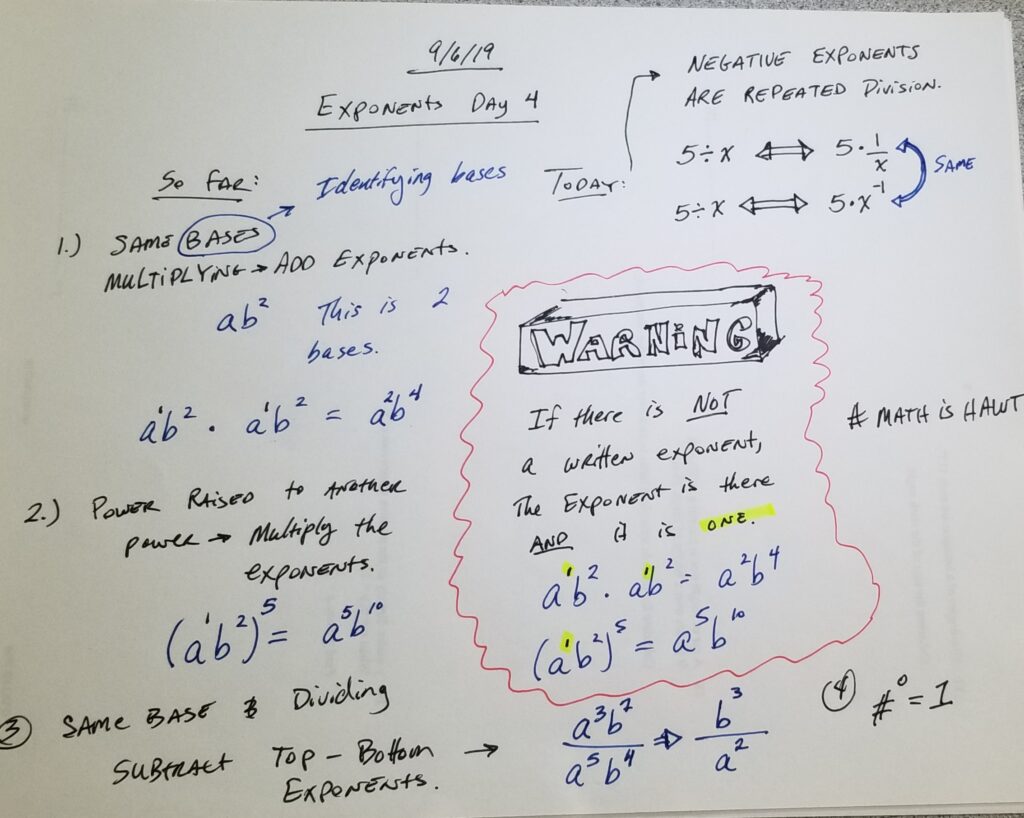
Of course confusion is exposed and can be properly addressed in other delivery forms. The message here is not that other methods are ineffective. However, students typically view a diversion from the script as tangential to the lesson objectives. They do not recognize that the diversion is the most important part of the learning. How could it be when it doesn’t have pretty animations and bold, underlined font?
The last benefit of a document camera is pacing. Students need think time. The pace of delivering a message is slowed when you, the teacher, are essentially taking notes with the students.
This allows them to think about what is being written while they write it. After all, you won’t be reading what you’re writing. Instead, your writing will be a summary of what’s been said!
With the slower pace, which has a higher engagement because students are using the time to carefully take notes, comes better questions from students. In response to these questions you can naturally annotate the notes throughout the lesson, highlighting the source of the confusion for the students continually.
What all of this means is that by using a document camera, a lot of the elements of quality teaching are naturally accessible. The pace is naturally improved to match the needs of students, the dialogue is improved, the exploration of misunderstanding is seamlessly incorporated into the lesson itself, without feeling tangential to the learning.
And all of that, especially the exploration of misunderstanding, provides the teacher with opportunity to provide for students what technology cannot do. It allows you to easily step into a role that you must carve out for yourself when using more advanced technology. The most important function of the teacher is to entice interest in students, to discover their motivations and to teach them instead of cover material.
How many times has this happened: You teach a lesson. The lesson is organized, complete, you’re proud of how it is constructed and delivered. The students seem okay. But when they test, the results are horrible.
This is what happens when we focus too much on the material, too little on the students. For me, anyway, the document camera really helps me to focus on the students. This is especially true with low-achieving students. They need more help, a slower pace, a more responsive teacher. Low-achieving students are less adaptive, flexible, and have less inclination to explore and challenge their understanding independently.
I am not saying, of the document camera, “This will revolutionize education.” The document camera, like all technology, is only as good as it is used.
What I have tried to show here is how the document camera naturally offers you opportunity to perform what cannot be scripted, what cannot be programmed into a computer, what need an expert on a video cannot fulfill. Your role as a teacher is to teach students, not cover material.
Whatever technology you use will fail to be effective if it is not used in a way that furthers that connection between students and content. If the technology only improves exposure to content, does not help students to engage with the content in a way that is challenging and builds conceptual understanding, then it, too, will be ineffective.
The take away is, there is not replacement for a good teacher. Tools that are used to enhance what a good teacher provides for a student are great. Tools that lose sight of what quality teaching is, ultimately, hamper the educational process and harm students.


